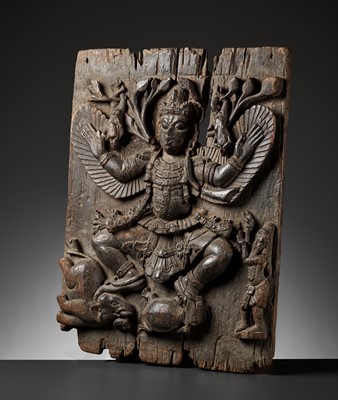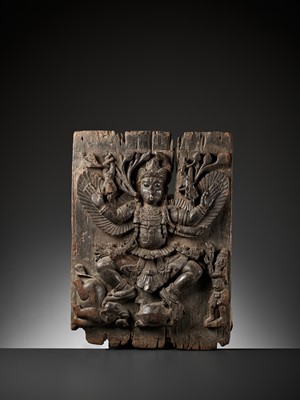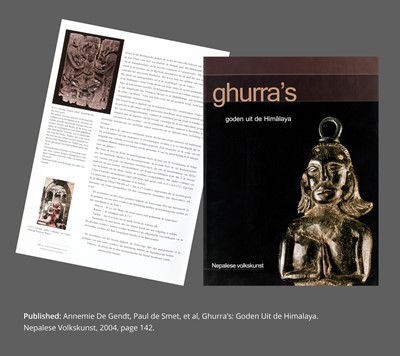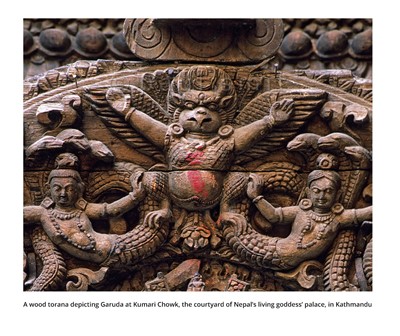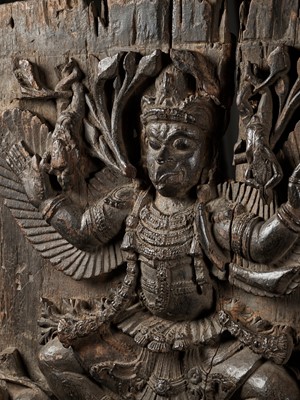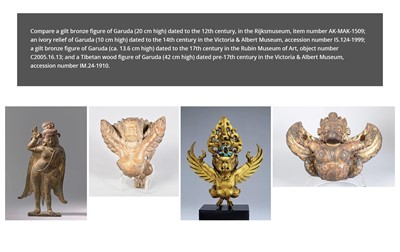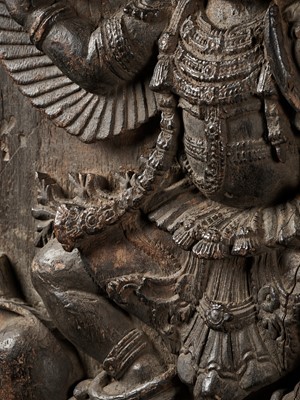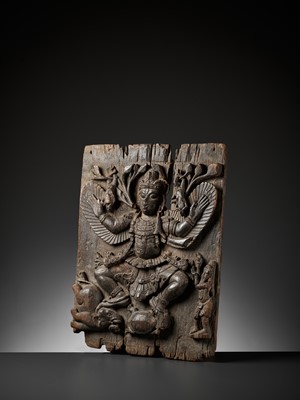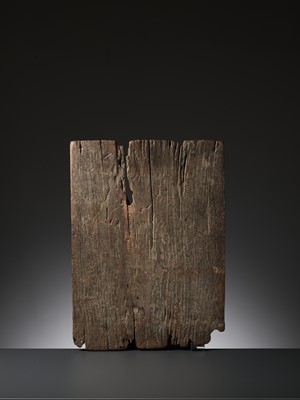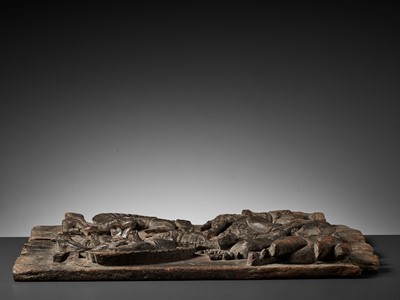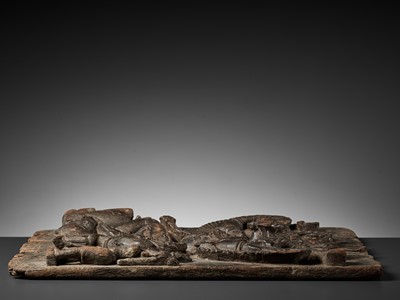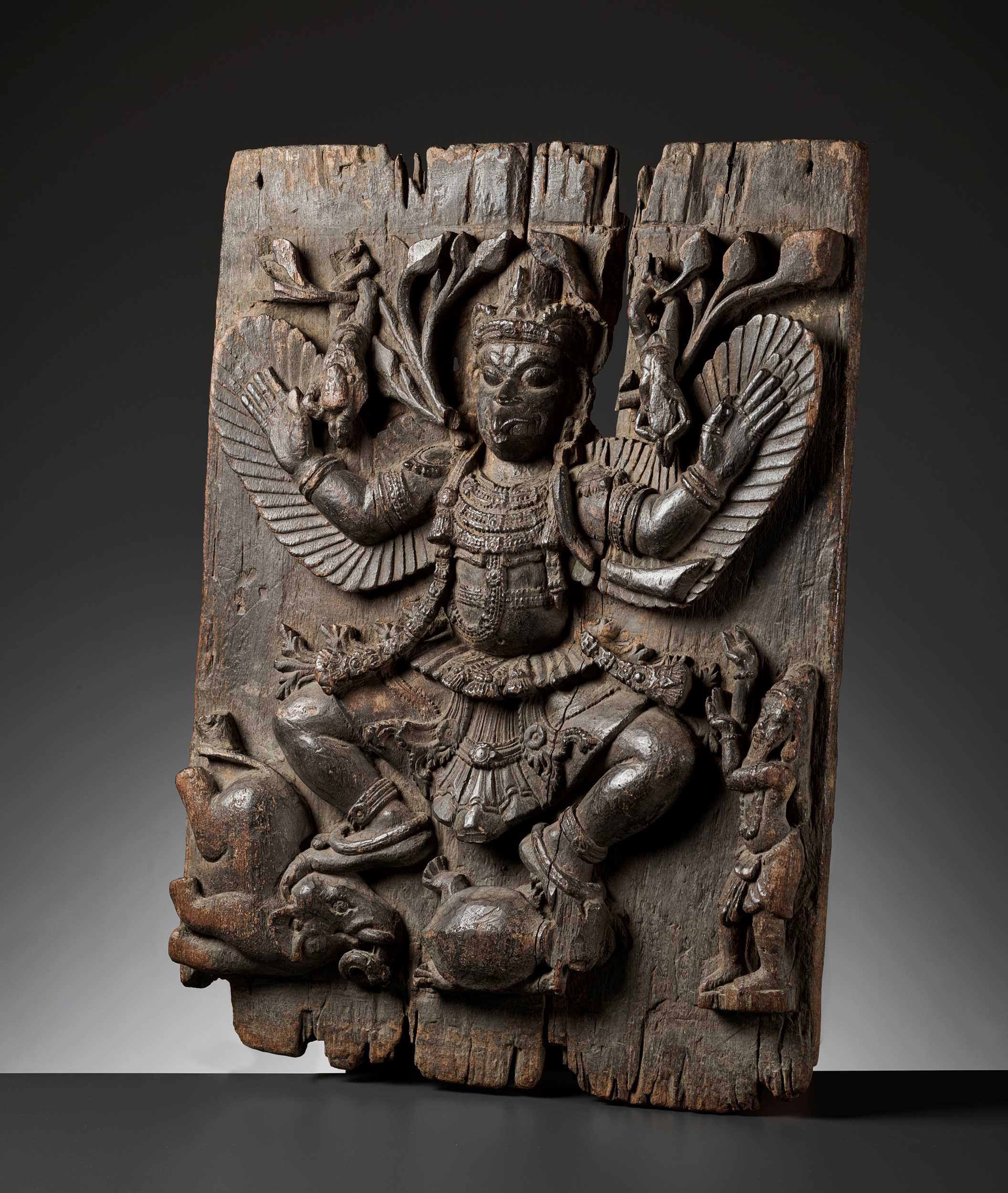11th Mar, 2022 10:00
DAY 2 - TWO-DAY AUCTION - Fine Chinese Art / 中國藝術集珍 / Buddhism & Hinduism
407
A RARE WOOD PANEL DEPICTING GARUDA WITH VIBHAVASU AND SUPRATIK
罕見木雕婁迦儸與維巴華素與蘇普拉提克兄弟的故事
Sold for €4,045
including Buyer's Premium
Nepal, 16th century. Boldly carved in high relief with Garuda standing atop prostate figures of Supratik and Vibhavasu as an elephant and tortoise, respectively. His legs and arms are bent with wings stretched outward as if about to take flight. He is richly adorned in beaded jewelry and wearing an elaborate crown. His face is carved with large almond-shaped eyes and a prominent beak. Two avatars of Vishnu are hanging upside-down from the foliate canopy toward the top of the panel and another figure stands to Garuda’s left.
Provenance: From an old German private collection.
Published: Annemie De Gendt, Paul de Smet, et al, Ghurra’s: Goden Uit de Himalaya. Nepalese Volkskunst, 2004, page 142.
Condition: Good condition, commensurate with age. Extensive wear, signs of weathering, losses, natural age cracks and splits. Fine, naturally grown patina.
Weight: 5,135 g
Dimensions: Size 62 x 47 cm
Garuda is a half-bird, half-human creature that appears in both Hinduism and Buddhism. In Hinduism, Garuda is the mount of the god Vishnu. Vishnu was the main deity of the north Indian Gupta rulers, and Garuda was their dynastic symbol. This royal association was adopted by Licchavi royalty in Nepal, becoming a quintessential icon in Nepalese religious imagery. Garuda is most commonly depicted kneeling on one knee or in flight with Vishnu on his back and is only rarely depicted standing, especially in Nepal.
The story of the two brothers Vibhavasu and Supratik is told in the Adi Parva of the Mahabharata. The elder one, Vibhavasu, was susceptible to anger, while the younger one, Supratik, was seeking to partition their wealth. One day both brothers were involved in a quarrel with each other. In the end, Vibhavasu then cursed Supratik, saying he will take birth as an elephant in the next life. In return, Supratik cursed his brother, saying he will be born as a tortoise. Anger and greed therefore caused them to be born as animals in their next birth and their hostility continued. One day the two were seized by Garuda, who took them in his claws to a mountain and ate them.
Literature comparison: Compare a gilt bronze figure of Garuda (20 cm high) dated to the 12th century, in the Rijksmuseum, item number AK-MAK-1509; an ivory relief of Garuda (10 cm high) dated to the 14th century in the Victoria & Albert Museum, accession number IS.124-1999; a gilt bronze figure of Garuda (ca. 13.6 cm high) dated to the 17th century in the Rubin Museum of Art, object number C2005.16.13; and a Tibetan wood figure of Garuda (42 cm high) dated pre-17th century in the Victoria & Albert Museum, accession number IM.24-1910.
罕見木雕婁迦儸與維巴華素與蘇普拉提克兄弟的故事
尼泊爾,十六世紀。高浮雕婁迦儸展翅,腳踏在大象維巴華素與烏龜蘇普拉提克兄弟身上。婁迦儸的腿和手臂彎曲,翅膀向外伸展,好像要起飛一樣。他佩戴著精美的珠飾,戴著精緻的王冠。他的臉上刻著杏仁狀的大眼睛和突出的喙。毘濕奴的兩個化身倒掛在面板頂部的葉狀樹冠上,另一個人物站在婁迦儸的左邊。
來源:德國私人老收藏。
出版:Annemie De Gendt, Paul de Smet, et al, Ghurra’s: Goden Uit de Himalaya. Nepalese Volkskunst, 2004, 頁142。
品相:狀況良好,與年齡相稱。 廣泛磨損、風化跡象、缺損、自然老化裂縫。包漿自然生長且十分細膩。
重量:5,135 克
尺寸:62 x 47 釐米
Nepal, 16th century. Boldly carved in high relief with Garuda standing atop prostate figures of Supratik and Vibhavasu as an elephant and tortoise, respectively. His legs and arms are bent with wings stretched outward as if about to take flight. He is richly adorned in beaded jewelry and wearing an elaborate crown. His face is carved with large almond-shaped eyes and a prominent beak. Two avatars of Vishnu are hanging upside-down from the foliate canopy toward the top of the panel and another figure stands to Garuda’s left.
Provenance: From an old German private collection.
Published: Annemie De Gendt, Paul de Smet, et al, Ghurra’s: Goden Uit de Himalaya. Nepalese Volkskunst, 2004, page 142.
Condition: Good condition, commensurate with age. Extensive wear, signs of weathering, losses, natural age cracks and splits. Fine, naturally grown patina.
Weight: 5,135 g
Dimensions: Size 62 x 47 cm
Garuda is a half-bird, half-human creature that appears in both Hinduism and Buddhism. In Hinduism, Garuda is the mount of the god Vishnu. Vishnu was the main deity of the north Indian Gupta rulers, and Garuda was their dynastic symbol. This royal association was adopted by Licchavi royalty in Nepal, becoming a quintessential icon in Nepalese religious imagery. Garuda is most commonly depicted kneeling on one knee or in flight with Vishnu on his back and is only rarely depicted standing, especially in Nepal.
The story of the two brothers Vibhavasu and Supratik is told in the Adi Parva of the Mahabharata. The elder one, Vibhavasu, was susceptible to anger, while the younger one, Supratik, was seeking to partition their wealth. One day both brothers were involved in a quarrel with each other. In the end, Vibhavasu then cursed Supratik, saying he will take birth as an elephant in the next life. In return, Supratik cursed his brother, saying he will be born as a tortoise. Anger and greed therefore caused them to be born as animals in their next birth and their hostility continued. One day the two were seized by Garuda, who took them in his claws to a mountain and ate them.
Literature comparison: Compare a gilt bronze figure of Garuda (20 cm high) dated to the 12th century, in the Rijksmuseum, item number AK-MAK-1509; an ivory relief of Garuda (10 cm high) dated to the 14th century in the Victoria & Albert Museum, accession number IS.124-1999; a gilt bronze figure of Garuda (ca. 13.6 cm high) dated to the 17th century in the Rubin Museum of Art, object number C2005.16.13; and a Tibetan wood figure of Garuda (42 cm high) dated pre-17th century in the Victoria & Albert Museum, accession number IM.24-1910.
罕見木雕婁迦儸與維巴華素與蘇普拉提克兄弟的故事
尼泊爾,十六世紀。高浮雕婁迦儸展翅,腳踏在大象維巴華素與烏龜蘇普拉提克兄弟身上。婁迦儸的腿和手臂彎曲,翅膀向外伸展,好像要起飛一樣。他佩戴著精美的珠飾,戴著精緻的王冠。他的臉上刻著杏仁狀的大眼睛和突出的喙。毘濕奴的兩個化身倒掛在面板頂部的葉狀樹冠上,另一個人物站在婁迦儸的左邊。
來源:德國私人老收藏。
出版:Annemie De Gendt, Paul de Smet, et al, Ghurra’s: Goden Uit de Himalaya. Nepalese Volkskunst, 2004, 頁142。
品相:狀況良好,與年齡相稱。 廣泛磨損、風化跡象、缺損、自然老化裂縫。包漿自然生長且十分細膩。
重量:5,135 克
尺寸:62 x 47 釐米
Zacke Live Online Bidding
Our online bidding platform makes it easier than ever to bid in our auctions! When you bid through our website, you can take advantage of our premium buyer's terms without incurring any additional online bidding surcharges.
To bid live online, you'll need to create an online account. Once your account is created and your identity is verified, you can register to bid in an auction up to 12 hours before the auction begins.
Intended Spend and Bid Limits
When you register to bid in an online auction, you will need to share your intended maximum spending budget for the auction. We will then review your intended spend and set a bid limit for you. Once you have pre-registered for a live online auction, you can see your intended spend and bid limit by going to 'Account Settings' and clicking on 'Live Bidding Registrations'.
Your bid limit will be the maximum amount you can bid during the auction. Your bid limit is for the hammer price and is not affected by the buyer’s premium and VAT. For example, if you have a bid limit of €1,000 and place two winning bids for €300 and €200, then you will only be able to bid €500 for the rest of the auction. If you try to place a bid that is higher than €500, you will not be able to do so.
Online Absentee and Telephone Bids
You can now leave absentee and telephone bids on our website!
Absentee Bidding
Once you've created an account and your identity is verified, you can leave your absentee bid directly on the lot page. We will contact you when your bids have been confirmed.
Telephone Bidding
Once you've created an account and your identity is verified, you can leave telephone bids online. We will contact you when your bids have been confirmed.
Classic Absentee and Telephone Bidding Form
You can still submit absentee and telephone bids by email or fax if you prefer. Simply fill out the Absentee Bidding/Telephone bidding form and return it to us by email at office@zacke.at or by fax at +43 (1) 532 04 52 20. You can download the PDF from our Upcoming Auctions page.
How-To Guides
How to Create Your Personal Zacke Account
How to Register to Bid on Zacke Live
How to Leave Absentee Bids Online
How to Leave Telephone Bids Online
中文版本的操作指南
创建新账号
注册Zacke Live在线直播竞拍(免平台费)
缺席投标和电话投标
Third-Party Bidding
We partner with best-in-class third-party partners to make it easy for you to bid online in the channel of your choice. Please note that if you bid with one of our third-party online partners, then there will be a live bidding surcharge on top of your final purchase price. You can find all of our fees here. Here's a full list of our third-party partners:
- 51 Bid Live
- EpaiLive
- ArtFoxLive
- Invaluable
- LiveAuctioneers
- the-saleroom
- lot-tissimo
- Drouot
Please note that we place different auctions on different platforms. For example, in general, we only place Chinese art auctions on 51 Bid Live.
Bidding in Person
You must register to bid in person and will be assigned a paddle at the auction. Please contact us at office@zacke.at or +43 (1) 532 04 52 for the latest local health and safety guidelines.
